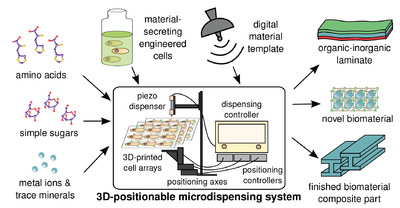NASA often provides small amounts of funding to check out some pretty unusual ideas. One of the projects they’re currently funding is the feasibility of an advanced biocomposite microdispening system.
Wait, what the heck is that? We told you this was an unusual idea! The proposition is to use micro-components already available in the space environment and “dispense” them in a 3D array to form useful structures. Sounds much like 3D printing to us, although on a micro-scale and using far-out materials.
The process overview above shows how the system would work (click for larger view), which essentially takes small bits and places them in 3D positions. Of course, the devil is always in the details. One can imagine the horrendously complex 3D models required to duplicate functioning biomaterials.
Lynn Rothschild of the NASA Ames Research Center says:
Imagine being on Mars with the ability to replace any broken part, whether it’s a part of your spacesuit, your habitat, or your own body. We propose a technique that would allow just that. By printing 3D arrays of cells engineered to secrete the necessary materials, the abundant in situ resources of atmosphere and regolith become organic, inorganic, or organic-inorganic composite materials.
Impossible? We hope not, because if this works, the spin off would be home 3D printers that really and truly are replicators.
Go NASA!
Via NASA


